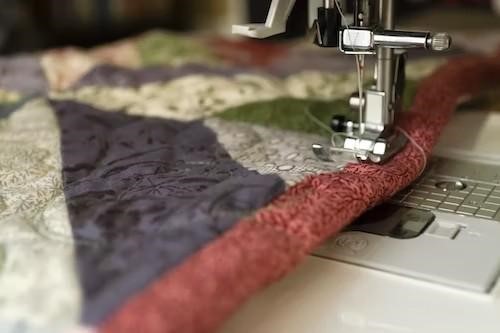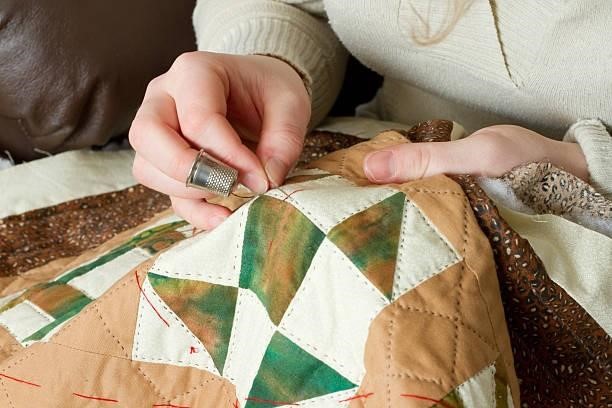
Subscribe To Emails
Subscribe to the YourCotton mailing list to receive updates on new arrivals and promotions (about once every 6 weeks)!

Quilting has become a popular craft and pastime for many, but what is quilting exactly? Quilting blends artistry with practical sewing skills to create beautiful designs that often have special meaning or purpose. From the intricate patchwork of individual fabric pieces to the warm comfort of hand-stitched quilts, this skillful stitching technique has been used for centuries to turn scraps into family heirlooms. To explore its fascinating history and uncover tips on how to get started on your quilt-making journey, keep reading!
Quilting is an age-old sewing technique traditionally used to create stunning artworks that can be proudly displayed in the home. Quilts are typically composed of three layers.
There’s a top layer made of fabric featuring intricate designs. The back layer is typically made of other fabric chosen for its practicality. The middle layer — known as “stuffed quilting” — helps provide the softness and warmth typical of handmade quilts.
To create these projects, quilters use sewing machines and precise hand-sewing techniques to ensure accuracy in form and design. The result is a one-of-a-kind piece sewn together with stories from the creator's life experiences as well as the meaning behind each stitch. The term "quilt" itself has deeper roots. Coined from the Middle English word 'cwilt', it refers to the act of stitching something together -- a unique representation of similar parts pieced together like a beautiful word quilt.
- Sewing machine (and maintenance kit)
- Rotary cutter
- The right sewing machine foot
- Needle
- Seam ripper
- Bobbins
- Basting pins or spray
- Acrylic rulers
- The Basics
Creating a beautiful quilt requires more than just sewing the pieces together. Quilting projects require careful design and planning before beginning. You need to make sure you have all the materials necessary. Additionally, you will also want to mark any measurements like quilt block sizes or seams that need to be made before sewing the layers of fabric together.
Once sewing is complete, it’s time to bind your quilt. This entails sewing the front and back of your project together through a process called applique. With each step in mind, you can easily create professional-looking quilts!

Hand quilting can be used in a variety of ways from creating quilt layers to making stunning wall hangings or clothing to decorating a patchwork quilt. This type of hand stitching requires that you use a needle and thread to create a running stitch across the entire surface area that needs to be worked on.
Depending on the pattern you are following, it is often necessary to have a quilting frame or hoop to keep the fabric in the precise position while working. Hand quilting binds all of the pieces of material together so that they form one large, thick section, giving you a beautiful finished product!
Additionally, within hand-quilting itself, there are many different options for stitches and patterns, such as rocking stitch or stab stitch. The different options allow for great choices when creating something truly unique and personalized.
Making quilts can be an enjoyable and creative hobby, but not everyone loves the idea of having to quilt all those layers together. If this sounds like you, then machine quilting might just be the solution you’re looking for. All it takes is a quilting frame, quilt top, and a basic running stitch or other decorative design – no need to hand quilt every single layer of your quilt!
And if quilted garments like jackets and skirts are more up your alley, machine quilting can be used to make them as well. Machine quilting is faster and easier than hand quilting, so give it a try – you might just find that it becomes your favorite new hobby.
Here are some tips for first-time quilters that will help you get started on the right foot.
One of the most important quilting tips for beginners is to choose the right fabric. The type of fabric you use will determine how your quilt looks and feels, so it’s important to take some time to select the right one. Cotton is a popular choice for quilters, as it’s durable and easy to work with. However, there are many other types of fabric available, so be sure to do some research before making your final decision.
Another important tip is to pre-wash your fabric before you start cutting and sewing. This will help to prevent shrinkage and color bleeding, which can ruin your quilt. Simply wash your fabric according to the instructions on the bolt, then dry it on a low setting or air dry it.
One of the keys to successful quilting is cutting straight lines. This can be tricky, especially if you’re using a rotary cutter. A good trick is to use a clear ruler with marked measurements, which will help you keep your cuts straight. You can also mark your fabric with chalk or a water-soluble pen before cutting to help guide your cuts.
To sew straight seams, it’s important to use a consistent seam allowance. When you sew, a seam allowance is an area between your fabric's edge and stitching line that creates space for adjustments or alterations. Most quilters use a 1/4″ seam allowance, but you can use a wider or narrower seam allowance if you prefer. Just be sure to use the same seam allowance throughout your quilt so that all of your seams line up correctly when you assemble it.

After you sew each seam, it’s important to press it open with an iron. This will help your quilt lie flat and prevent bulkiness at the seams. Simply place your iron on top of the seam and press down firmly. Then open up the fabric and press the seam flat with your fingers before moving on to the next seam.
In conclusion, quilting is an interesting and complex art form with a long history. There are many different techniques and styles of quilting, and it can be used for both functional and decorative purposes. If you're interested in learning more about quilting, there are plenty of resources available to help you get started. The first step? Choose your fabric!
YourCotton has plenty of selections to help you get started with a quilt that is uniquely you.